
© Google Maps, 2008
The history of the camp at Cassino is described in some detail by Sergio Saragosa from his research in the Frosinone archives. He states that, when it became necessary to build a POW camp, an area of land was quickly requisitioned from the then owners on either side of the current road between Cassino and Caira, though compensation was much slower in coming, with some of it still outstanding in 1918. An inspection carried out on 14 February 1919 revealed that 35,000 prisoners were interned in the camp, including some 2,000 officers. In 1920, once all the internees had been repatriated, the huts were occupied by the 7,000 pupils of the Carabinieri Cadet School, later by the Artillery and then by the Italian army as a store for shoes, clothing and other articles. The stores were requisitioned in 1943 by the German occupiers for their own army, with the local populace being forced to pack and make an inventory of each item. After the war the main part of the camp, on the right hand side of the road, was demolished. The remaining huts on the left hand side were used as a storage depot for the Artillery, an area covering 24,000 square metres with a perimeter wall of 920 metres, topped by barbed wire. The whole area, known to the locals as the “concentramento”, is now deserted, overgrown and snake-infested.
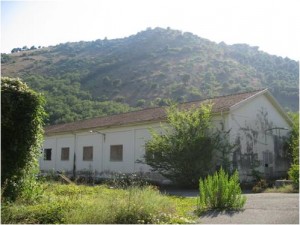
Josef Kolbe was already at the camp in Cassino in October 1917, a month after his capture. He left no description, but the reminiscences of two internees give a good account of what daily life was like.
Dir. Prof. Dr. Ludwig Hänsel arrived in the camp on 18 November 1918. He was allocated a room (generally shared by four or five men) in one of the huts, together with a camp bed, two clean sheets and two blankets. The huts were made of thin but solid bricks and covered by a tiled roof, which enabled air and noise to be carried along the whole length of the building, as the two metre high partitions between the rooms did not have ceilings. The less fortunate internees were assigned to one of the larger huts, which had only four rooms, with beds packed close together against the two longer walls, forming a central corridor. Without a ceiling to provide any insulation, the occupants of all the huts suffered from the annual variations in temperature – extreme cold in the winter (especially when one of their blankets was taken away) and stifling heat in the summer.
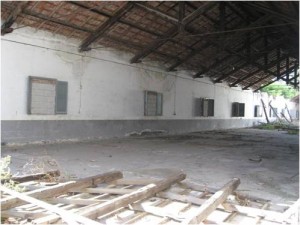
The living quarters for the officers, of whom there were 1,700 in 1919, were divided into two distinct areas, one for the Germans and the other for the Hungarians. The kitchen stood in the middle and on either side were the refectories, where meals were taken in three sittings. To begin with there were food shortages, even for those who had a few lire in their pocket, but once these initial difficulties had been overcome, food was even plentiful. Dr. Hänsel enthuses about the figs in winter and the oranges in summer. Cigarettes were also always available and matches were saved by lighting one cigarette from another. There was a large open area where the internees could meet to talk or exercise. Various clubs – music, theatre, literature, philosophy, painting, gymnastics, football, etc. – were formed to keep the men busy. Shows were performed and there was even a large, well run library.
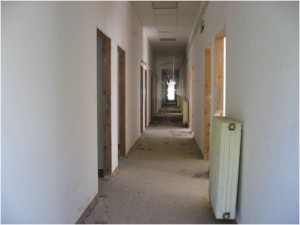
Franz Parak, an Austrian schoolteacher, who was interned at the same time as Dr. Hänsel, describes two rows of huts surrounded by a high wall, which would indicate that he was interned in the part of the camp on the left hand side of the current road, where several huts still remain standing. He states that the officers were given ration cards according to their rank for all their needs, including food, which was provided by the Italians but prepared by Austrian cooks. The food was good, but his ration cards were not sufficient to satisfy his hunger, and it was only when he and his fellow officers of the same rank were all promoted to the rank of Lieutenant, that they were able to purchase rations on which they could subsist.
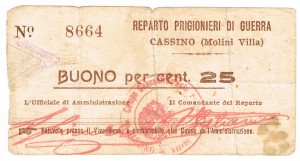
The two refectories were used during the day for lectures and the rest of the time could be spent reading books donated by a Swiss society (presumably the Red Cross) and pacing the road that divided the two lines of huts or walking interminably around the open area not far from the huts. It was during his perambulations that he noticed a new arrival, Ludwig Wittgenstein, later to become a well-known philosopher, with whom he became acquainted through Dr. Hänsel. Parak and Wittgenstein became firm friends and it was thanks to his discussions with him, Dr. Hänsel and others and the courses he took in Logic, German literature and the Italian language that he concluded that his time spent at Cassino was “una buona università”.
The graveyard on the right of the road between Monte Rotondo and Caira contains a tomb with the remains of the Austrian-Hungarian troops that died at the camp. There is no indication as to how many men are buried there, but a large number of bones are held in crates under the floor of the chapel.
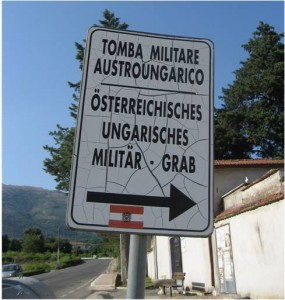 | 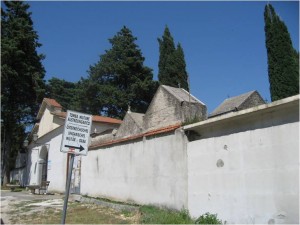 | 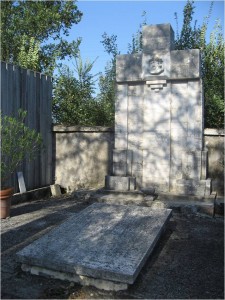 |
Sources:
Storia del deposito di artiglieria della contrada Monte Rotondo di Cassino, Sergio Saragosa: http://www.cassino2000.com/cdsc/studi/archivio/n06/n06p02.html
In Feindeshand: Gefangenenlager bei Cassino, Dir. Prof. Dr. Ludwig Hänsel
Wittgenstein prigioniero a Cassino, Franz Parak, Dario Antiseri: http://www.roangelo.net/logwitt/acassino.html
